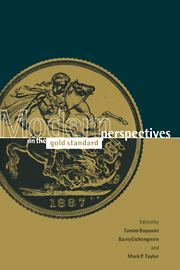Book contents
- Frontmatter
- Contents
- List of figures
- List of tables
- Notes on the contributors
- I Introduction
- II Operation of the gold standard
- III Adjustment mechanisms
- 6 The stability of the gold standard and the evolution of the international monetary fund system
- 7 International adjustments under the Classical gold standard: evidence for the United States and Britain, 1879–1914
- 8 Balance of payments adjustment under the gold standard policies: Canada and Australia compared
- IV Monetary issues
- V Exchange rate behavior
- VI Conclusions
- Index
7 - International adjustments under the Classical gold standard: evidence for the United States and Britain, 1879–1914
Published online by Cambridge University Press: 05 November 2011
- Frontmatter
- Contents
- List of figures
- List of tables
- Notes on the contributors
- I Introduction
- II Operation of the gold standard
- III Adjustment mechanisms
- 6 The stability of the gold standard and the evolution of the international monetary fund system
- 7 International adjustments under the Classical gold standard: evidence for the United States and Britain, 1879–1914
- 8 Balance of payments adjustment under the gold standard policies: Canada and Australia compared
- IV Monetary issues
- V Exchange rate behavior
- VI Conclusions
- Index
Summary
Introduction
Links between disturbances in financial markets and those in real activity have been the focus of studies of economic fluctuations during the period prior to World War I. The standard “business cycle” analysis of the period emphasizes the importance of domestic monetary shocks in an environment of sticky prices and inelastic money supply. In this chapter, we provide evidence suggesting that those basic assumptions are at odds with the data from the period. Domestic autonomy was substantially limited by internationally integrated markets for gold, capital, and traded commodities. Such findings are likely to be important for studying business cycles during the period; for example, we have shown elsewhere (see Calomiris and Hubbard, 1989) that, when prices are flexible, observed cyclical movements can be related to a credit market transmission of deflationary shocks.
The focus on international linkages has been common in the literature; indeed, recent studies of the operation of the Classical gold standard have revived interest in the process by which macroeconomic shocks were transmitted internationally during this period (see Eichengreen, 1985; Bordo and Schwartz, 1984). The principal competing approaches differ according to the means by which international equilibrium is re-established after a disturbance occurs in capital, money, or commodity markets.
- Type
- Chapter
- Information
- Modern Perspectives on the Gold Standard , pp. 189 - 217Publisher: Cambridge University PressPrint publication year: 1997
- 2
- Cited by



